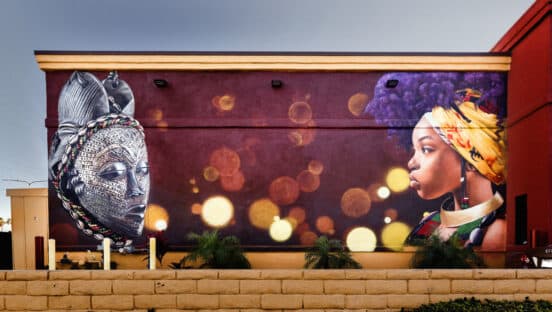Ambiance matters. In a study of 5,000 New York City restaurants, patrons reported being influenced by ambiance (and service) more than food quality. One way to create an authentic, appealing atmosphere? Thoughtful and meaningful art. Large-scale, impactful art can create positive energy that resonates with customers. By incorporating murals across diverse spaces (both public-facing and corporate), restaurants have the potential to not only attract customers, but boost employee engagement, productivity and well-being.
Here’s how incorporating art across front-of-house and behind-the-scenes spaces can benefit both company culture and the bottom line.
Strengthen Brand Awareness
Big art stands out. Research shows that while traditional out-of-home advertising increases impressions, murals can generate organic conversations and interactions money can’t buy—drawing consumers in and fostering organic dialogue. Such large-scale art is also an extension of a brand, communicating a company’s mission and values to patrons and insiders alike.
Whether employees are working in accounting or directly serving customers, feeling connected to—and inspired by—company branding is key to nurturing a strong company culture. It may also help dispel that “stuffy” stereotype when it comes to corporate workplaces.
For example, when Chick-fil-A wanted to bring energy and excitement to its new corporate office location in Irvine, California, it enlisted local artist Jesse Brown to infuse both the brand’s color palette and the sunny west coast vibe into the new building. The resulting mural infused the space with energy and a sense of place.
Alleviate Stress
Creating a pleasant environment isn’t just about attracting patrons and making them comfortable—albeit, those factors are hugely important. Art can also play a significant role in enhancing employee well-being. Given that service industry workers experience disproportionately high levels of stress, installing art in a day-to-day workspace can play a small role in reducing anxiety on the job. According to Psychology Today, several research studies indicate that viewing art can lead to decreased cortisol levels as well as self-reported reduction in stress.
Increase Productivity
A 12-year University of Exeter study found that people working in “enriched” spaces decorated with art and plants were 17 percent more productive and efficient than their counterparts working in “lean” (a.k.a. stark) spaces. Additional surveys and studies have shown that art in workplaces helps increase creativity, willingness to express opinions and reduces negativity.
Create Connections and Reinforce Values
Gallup reported that just 33 percent of U.S. employees were “engaged” in their work in 2023—indicating today’s workers feel more detached from their employers, less satisfied with their organization and more disconnected from their company’s mission than they were four years ago.
Art can help reinforce a company’s values while creating connections and touchpoints for informal conversation. According to a University of Texas at Dallas Derive Art survey, 75 percent of employees experienced new discussions with coworkers following a workplace art installation. By creating human-to-human connections and visually reinforcing a company’s core purpose, art helps nurture a more positive workplace culture.
Instill A Sense of Authenticity
Restaurants have the power to become a pillar within their communities, as long as they authentically represent the local culture. Local artists who understand the community character play a key role in translating genuine feeling and messaging into a brand’s art. For example, when Shake Shack opened locations in Brooklyn and Seattle, the company shied away from a cookie-cutter, big chain look. Instead, it enlisted local artists to deliver murals that spoke to the nuances of the distinctly different neighborhoods while staying true to the brand.
Of Note: To reap the upsides of public-facing and corporate murals, each unique project needs to align with a company’s specific set of goals. Whether showcasing a brand’s values, infusing energy into a space, meshing with the neighborhood vibe, inspiring employees and customers or some combination of all elements, creating an impactful art installation requires intention. Translating that message into art also requires the right artist— someone whose work lends authenticity to the project.
The Takeaway: A mural isn’t just a cool marketing tool designed to attract patrons and Instagram posts—though, admittedly, that’s all great for business. Instead, consider its holistic impacts, particularly in the HR realm. When thoughtfully incorporated into a company’s restaurants and office spaces, art has the potential to engage employees, increase efficiency and play a powerful, role in strengthening culture, community and purpose.
Tricia Binder is a co-founder and President of Muros, a startup that brings together local mural artists with brands and businesses to create unique and impactful spaces, environments, and outdoor advertising campaigns.














